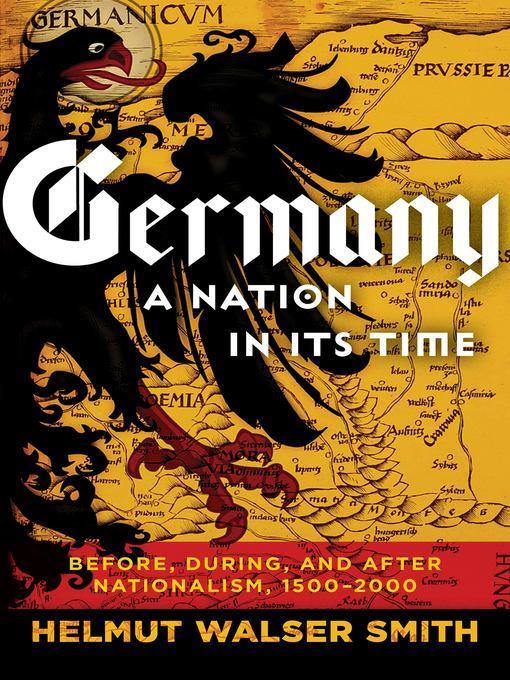
Germany
A Nation in Its Time: Before, During, and After Nationalism, 1500-2000
کتاب های مرتبط
- اطلاعات
- نقد و بررسی
- دیدگاه کاربران
نقد و بررسی

January 1, 2020
A noted historian outlines the development of the German nation in novel ways. Smith (History/Vanderbilt Univ.; German Nationalism and Religious Conflict: Culture, Ideology, Politics, 1870-1914, 2016, etc.) begins his account in 1500, when there was no Germany as such but instead a collection of cities and mostly small principalities: "No charts drew the German lands to scale and no drawings showed its borders. And no one had described Germany as a space with a recognizable shape." Modern cartography would change this, marking German itineraries and linking German-speaking cities into a "Germania" that "was an act of discovery, not chauvinism." However, chauvinism would soon follow: Martin Luther railed that the humanism of mapmakers and scholars had "Judaizing tendencies" that yielded too much to "the enemies of Christ." In time, nationalism would replace the former German devotion to hometowns, and it found expression in the depopulating Thirty Years' War, which took decades to recover from. On that note, Smith writes, although millions of Germans lost their lives during the Hitler years, recovery was swift--and although a majority of Germans believed, just after the war ended, that national socialism was a meritorious system whose leaders had merely taken a few missteps, by the time the "economic miracle" was at work in full force, most conversely saw that Hitler had been ruinous. German nationalism today is a very different thing from its manifestations in the two centuries prior. Smith writes of a crowd of soccer fans cheering for their team against Portugal during the 2006 World Cup and finally feeling comfortable enough about being German to wave their national flag. Even though Germans are now resolute internationalists, Smith concludes, there are troubling rumblings of a reborn nationalism in opposition to the German government's comparatively open-door policy toward immigrants and refugees, so that "public discourse now seems increasingly rife with prejudice toward outsiders." Fruitful reading for students of modern European history and the rise of nationalism.
COPYRIGHT(2020) Kirkus Reviews, ALL RIGHTS RESERVED.

January 13, 2020
Vanderbilt University history professor Smith (The Butcher’s Tale) traces shifting concepts of the German nation across five centuries in this dense and erudite account. Disputing the prevailing notion that WWI- and WWII-era nationalists invented the idea of the German nation, Smith details how maps drawn before and after the Thirty Years’ War (1618–1648) helped to concretize an initially vague, slowly emerging conception of “German lands.” Massive deforestation in the 18th and 19th centuries contributed to the decline of local and regional loyalties, Smith writes, and German nationalism, which “was from the beginning tied in complex ways to anti-Jewish sentiment,” emerged with greater clarity and force during the early-19th-century Napoleonic Wars. Ultimately, the belief that “allegiances to the nation should supersede other loyalties” flourished only in the 75 years between German unification under Otto von Bismarck and the defeat of Adolf Hitler’s Third Reich. Unfortunately, the book’s somewhat underdeveloped portrait of the post-nationalist era (1945–present) contains little discussion of how visions of a “European community” and plans for Holocaust reparations gained support in West Germany. Smith’s lucid prose and insightful character sketches keep the deluge of names, dates, and border realignments from becoming too disorienting. Readers with a deep interest in the evolution of modern Europe will relish this thorough revisionist history.

February 1, 2020
Rather than focusing on politics, diplomacy, and nationalism as a lens through which to understand the origins of the German nation, Smith (history, Vanderbilt Univ.) considers the role of maps in defining German land and identity between 1500 and 2000. Many of these maps do not describe a rigidly defined border to Germany; Smith reminds readers that prior to unification (1871), many inhabitants identified themselves by their region or principality, not by ethnic nationality. After the devastation of the Thirty Years War (1618-48), some states, such as Prussia and Austria, became increasingly militarized. In the 19th century, Germany was better known for its Romantic writers than for its armed forces. But after 1918, Smith asserts, Germany struggled to justify the devastating losses of World War I, which opened the door to a new type of racialized, militant nationalism that made the Holocaust possible. VERDICT Smith rejects the notion that German history is the story of militant nationalism marching toward genocide, and instead focuses on cartographers intellectuals who, prior to 1918, often described the landscape and ethnography of Germany in pacifistic terms. This new perspective on German history should be welcomed by all libraries.--Frederic Krome, Univ. of Cincinnati Clermont Coll.
Copyright 2020 Library Journal, LLC Used with permission.

February 15, 2020
Smith's robust history of German nationalism emphasizes evolving notions of nationhood and continuities that have endured despite 500 years of tumult. Once a hodgepodge of dissimilar city-states and warring principalities, Germany began the nineteenth century with an assertively defined sense of self that the twentieth century would see weaponized to devastating effect. How did this happen? Prior narratives have pointed to Napoleon's occupation of Prussia as the moment in which Germans came together under the banner of nationalism. But Smith suggests an earlier quickening, as advances in transportation and cartography, along with the shared trauma of the Thirty Years' War, gave rise to a uniquely German national identity. While perceptions of Germanness would change to meet shifting politics and outlooks, Smith argues, certain features would persist, including notions of violence, exclusion, and primacy. Powerful chapters on the losses of WWI and the death spaces of WWII underscore different dimensions of sacrifice, another salient expression of German nationalism. And if today's German identity seems to privilege internationalism and compassion (and perhaps soccer), uglier impulses remain. Fresh ideas, lots of maps, and vivid prose.(Reprinted with permission of Booklist, copyright 2020, American Library Association.)

























دیدگاه کاربران